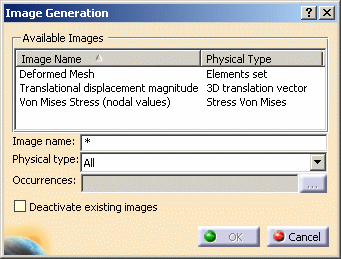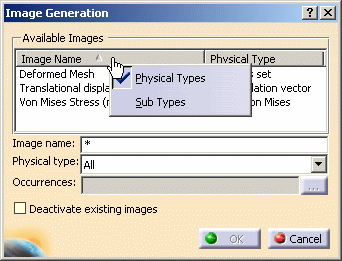|
The Image Generation dialog box appears.

-
Available Images: lets you select the
type of image you want to visualize.
You can select several images. To do this, press the Ctrl
key and select in sequence the desired images.
 |
Available images depend on the current case
type.
|
Case solution type |
Available image |
|
Static Case |
- Deformed Mesh
- Translational displacement magnitude
- Von Mises Stress (nodal value)
|
|
Frequency Case* |
- Deformed Mesh
- Translational displacement magnitude
- Von Mises Stress (nodal value)
|
|
Free Frequency Case |
- Deformed Mesh
- Translational displacement magnitude
- Von Mises Stress (nodal value)
|
|
Buckling Case |
- Deformed Mesh
- Translational displacement magnitude
|
|
Combined Case |
- Deformed Mesh
- Translational displacement magnitude
- Von Mises Stress (nodal value)
|
|
Static Constrained Mode |
- Von Mises Stress (nodal value)
|
|
Harmonic Dynamic Response Case |
- Deformed Mesh
- Translational displacement magnitude
- Von Mises Stress (nodal value)
|
|
Transient Dynamic Response Case |
- Deformed Mesh
- Translational displacement magnitude
- Von Mises Stress (nodal value)
|
*For the
Frequency Case, the mode shapes are arbitrarily normalized
displacements. In this case, the images of stress and energy
results give only tendencies related to these mode shapes. |
-
Image name: lets you filter the
available images according to the name.
You can click the Image Name menu to change the order
of the list.
You can use the * symbol. For example: *disp*
lets you filter all the images that contain the string disp.
-
Physical Type: lets you filter the
available images according to the physical type.
-
Sub Types: lets you filter the
available images according to the sub-types.
You can also decide to display or hide the physical
type and sub-type information in the Image
Generation dialog box.
To do this, right-click the bar and select the desired contextual
menu.

|
![]()